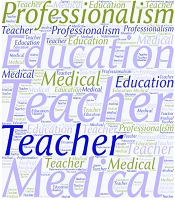Dear Editor,
Although the term “medical professionalism” is widely used in the medical education literature, it is safe to say that very few cases have addressed “medical teacher professionalism.” On the other hand, a glance at the most critical educational databases leads the interested scholar to limited evidence about the characteristics of a professional teacher. It is necessary to answer a few basic questions to address medical teacher professionalism.
What is professionalism, and who is a professional? In a simple definition, professionalism is a mixture of professional expertise and commitment. Therefore, in addition to having sufficient knowledge and skills in his/her field, a professional also sees himself/herself as committed to adhering to a set of professional and ethical principles. From ethics to professionalism (etiquette) is a road paved with morality. A professional must inevitably learn moral virtues to safely travel from the origin of ethics to the destination of etiquette and reach a position where he/she can declare and acknowledge his/her abilities and inadequacies. Altruism, humanities, excellence, and accountability are some of these moral virtues. Edmund Daniel Pellegrino, a famous American bioethicist, explained that the etymology of the word “professionalism” indicates that the act of a professional is to make a loud declaration of his/her commitment to a profession (1). According to this quote, the key concept in defining professionalism is declaring aloud, i.e., explaining and explicating relevant duties and commitment explicitly.
What is professional teaching, and who is a professional teacher? An Australian lawyer and teaching specialist, Nigel Wilson, quoted American motivational author William Arthur Ward in his excellent book, Teaching Professionals: The Art of the Teaching Professionals and How to Teach Professionals (2). According to William Arthur Ward, “The mediocre teacher tells. The good teacher explains. The superior teacher demonstrates. The great teacher inspires.” It is clear from these statements that the development of the teaching profession goes beyond mere “saying” and ends with “inspiration.” Undoubtedly, the condition for attaining the status of inspiration is the acquisition of moral and intellectual virtues, some of the most important of which is accountability, high ethical standard, self-assessment, intellectual humility, intellectual integrity, intellectual perseverance, intellectual courage, intellectual empathy, intellectual autonomy, fair-mindedness, and confidence in reason (3). The essential dimensions of these moral and intellectual virtues need to be explicitly disclosed in the presence of others by a professional teacher. In addition to demonstrating professionalism in a teacher’s knowledge characteristics, in a hierarchy of skill acquisition, the professional’s journey from competency to mastery begins with emotional attachment to the task and ends with intensive absorption in the profession (4). Undoubtedly, inspiration in teaching and absorption in the teaching profession are two salient features of a professional teacher.
What is the meaning of teaching? According to Wilson,” Teaching is many things-a career, a profession, a calling, a vocation, and a gift.” (2). By this comprehensive definition, teaching is a subject beyond a professional job, and a teacher is a human being beyond a professional. In fact, it can be said that education is a precious gift given to the teacher enabling him to cultivate good people. Perhaps this is why Fred, a medical educator, writes in his valuable paper: “Good students make teachers look and feel good” (5).
And last but not least, what do professional medical teachers have to declare aloud? Unlike previous questions that had clear answers in literature, there is no clear and straightforward answer to this question in the scholarly sources. In my opinion, a medical teacher should be committed to the students and the curriculum. The medical teacher should encourage students to actively learn and practice more to apply the key concepts in the real situation, strengthen self-assessment in them, evaluate students to strengthen their thinking, explain the final evaluation and scoring method to them, use specific strategies to eliminate the common disabilities of learners, strengthen systematic and Socratic questioning (asking many questions and supplying few answers) in them, and foster important intellectual virtues in students. Regarding the curriculum and instruction, the medical teacher is committed to preparing an active course plan for students, presenting the lesson plan at the beginning of the course, and explaining the educational expectations to the students. The medical teacher must connect the content of the course and the objective situations of life and emphasize the systematicity and coherence of the course content. Undoubtedly, a professional medical teacher will declare aloud all these to his teaching clients.
